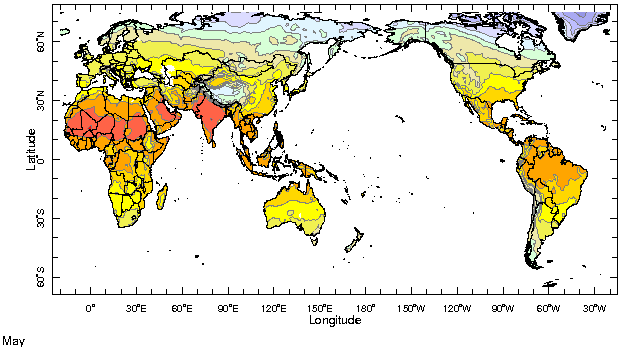|
IRI Climate Digest
June 2004
May Global Climate Summary
Climatological Background
In May, the sun is well into its march north of the equator (the maximum northward location will be achieved in June at 23.6 degrees north). Surface heating of the continents is setting the stage for summer monsoonal systems or northern hemisphere warm season rains. The lack of direct solar heating in the southern hemisphere creates a north-south temperature difference which strengthens mid-latitude storm tracks and the approach of winter.
Monthly Mean Temperature (1961-1990), data from the Climate Research
Unit, University of East Anglia


Monthly Mean Precipitation (1961-1990), data from the Climate Research
Unit, University of East Anglia


Temperatures
Highlights
Temperatures were well above-average during May across much of central Asia, as departures of more than 4°C above normal were observed in central Russia. This relative warmth is consistent with the below-normal precipitation in the region during May and is in stark contrast to the -5°C departure from normal experienced in some of the same areas during April. Above-average conditions also prevailed across central and southern Africa, eastern Russia and Alaska, central North America, and northeastern South America. Below-normal temperatures prevailed across much of Canada and southern South America. Central Canada experienced temperatures that averaged over 6°C below normal during the month of May while Paraguay and northern Argentina saw monthly departures of 3-4°C below normal.
Temperature Difference from the 1961-1990 mean, with data
from NCEP Climate Prediction Center, CAMS.


Precipitation
Highlights
An early onset to the southwest summer monsoon was observed in India, with above average rainfall extending from the Bay of Bengal northeastward to east-central China. The rainy season was off to a mixed start in West Africa, while unusually dry conditions marked the end of the long rains in eastern Kenya and Tanzania. Unusually dry conditions across the northern Caribbean region were punctuated by a short period of very heavy rainfall, accompanied by severe flooding in Haiti, during the second half of May.
Precipitation Difference from 1979-1995 mean, with data
from NCEP Climate Prediction Center, CAMS-OPI.


Oceanic Conditions
Tropical Pacific: Near-normal to slightly warmer-than-normal sea surface temperatures persisted in the waters of the Indonesian archipelago and the equatorial western Pacific west of the date line in May. Most of the central equatorial Pacific exhibited near-normal temperatures. The tongue of colder-than-normal surface water curving northwestward from the coast of Peru to about 110°W began to develop in mid-April and persisted through the month of May. See the latest IRI ENSO Update for a detailed summary and outlook.
Tropical Atlantic: Conditions in most of the tropical Atlantic were close to average in May, with the exception of cool waters off the coast of Africa between the equator and 10°S, cooler-than-normal temperatures in the Gulf of Mexico and vicinity, and warmer-than-normal SSTs off South America north of the equator.
Indian Ocean: Warmer-than-normal temperatures persisted in the central Indian Ocean in May, but areas of the northern, eastern and southern regions of the basin cooled with respect to climatology. However, waters off the west coast of Australia warmed by as much as 1°C between April and May.
Pacific Mid-latitudes: The large area of above-normal temperatures in the central South Pacific persisted in May as it has for several months. In the North Pacific, a long swath of above-normal temperatures from about 10°N to the west coast of North America strengthened between April and May. With the exception of a small area of cooler-than-normal temperatures around Japan, much of the western Pacific basin was warmer than normal.
Monthly Sea Surface Temperature Difference from the 1971-2000 mean,
with data from the Environmental Modeling Center, NCEP/NOAA.


Contents |
Special |
Impacts |
Climate |
Forecast
| 
